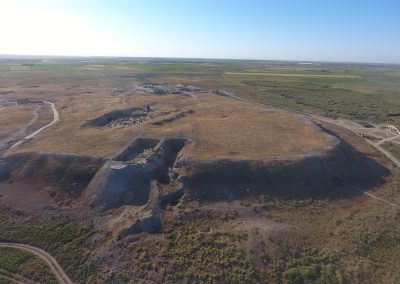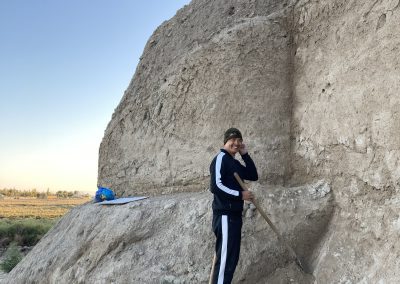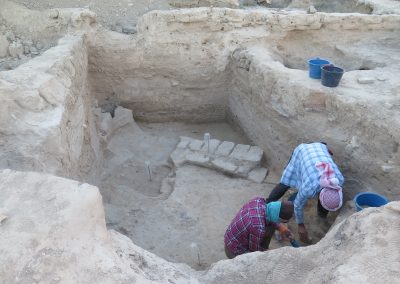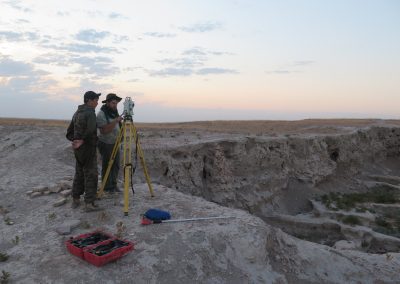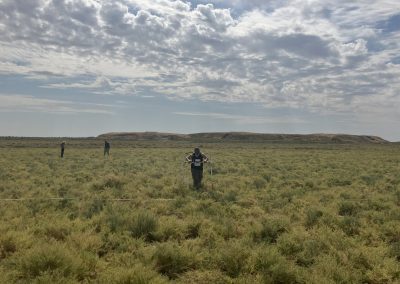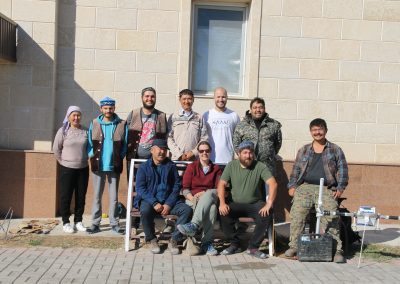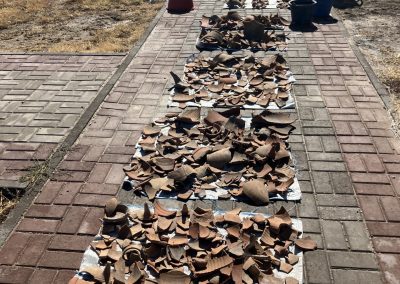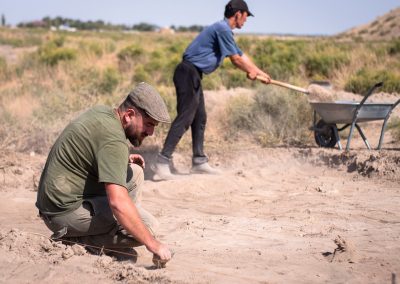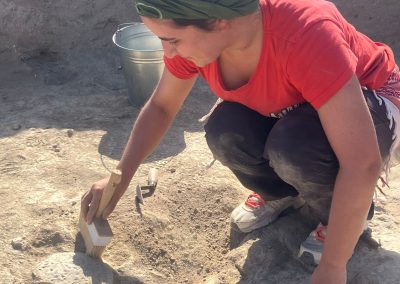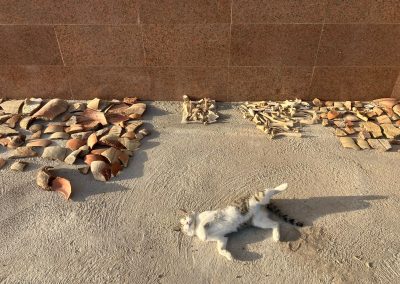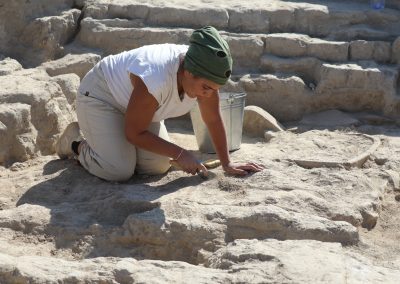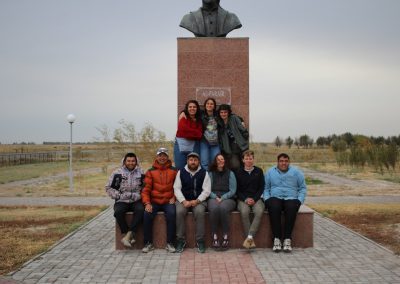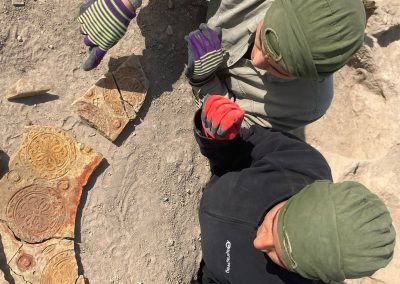Agricultural Sustainability of the Otrar Oasis
Project Summary
The Otrar Oasis in southern Kazakhstan is situated on a fertile plain between the Syr Darya and one of its major tributaries, the river Arys. The city, which is also know as ‘Farab’, was a regional capital from the 8th century AD and occupied until the 18th century. Otrar’s surrounding hinterland contained a complex network of canals which brought water from the Arys. These led towards the city and watered fields for the cultivation of various crops, and so provided both food and water to the numerous urban settlements in the area (Clarke, Sala, and Meseth 2005; Groshev 1985; Toonen et al. 2020). Effective irrigation of this arid landscape was crucial to support the large populations in cities, which profited from their positions on trade routes stretching across Central Asia to China, the Middle East and beyond. Otrar is notable in the historical sources as being the first Khawarazmshah city to face the Mongols during their westward advance in 1219-20 and the location of Timur’s death in 1405. It has been archaeologically investigated by Soviet and international teams since the 1960s. Like many similar medieval cities in the region, the site is now abandoned, and the population density may now be lower than in the 12th century. The ‘Agricultural Sustainability of the Otrar Oasis’ project aims to explore why this is the case.
Environmental degradation or mismanagement is both a likely contributor to urban decline in these space-limited oases, and a salient current issue. Focussing on Otrar, the programme of fieldwork and analysis will focus on urban stratigraphy and charred seeds to date population decline in the city and investigate its agricultural economy. Fieldwork will be complemented by a pilot project of isotopic analysis to determine its feasibility to show shifts in water provision and soil fertility. This data and its archaeological context will be used to assess the contribution of environmental deterioration and human responses to urban decline at Otrar.
Building on recent excavations at the site and in partnership with the Otrar State Archaeological Museum (Akylbek 2013; Campbell 2020, 2021; Campbell et al. 2022), the project involves a programme of targeted geophysical survey, excavation, archaeobotanical analysis and radiocarbon dating. It will partner with the Leverhulme-funded ‘Rivers of the Silk Roads’ project (led by Prof. Mark Macklin, Lincoln) which is investigating how water impacted cities and societies in Central Asia over the past 2000 years. The BIPS flagship grant will provide crucial funding to understand a somewhat overlooked part of the Persianate world, and will transform our understanding of the agricultural economy at Otrar.
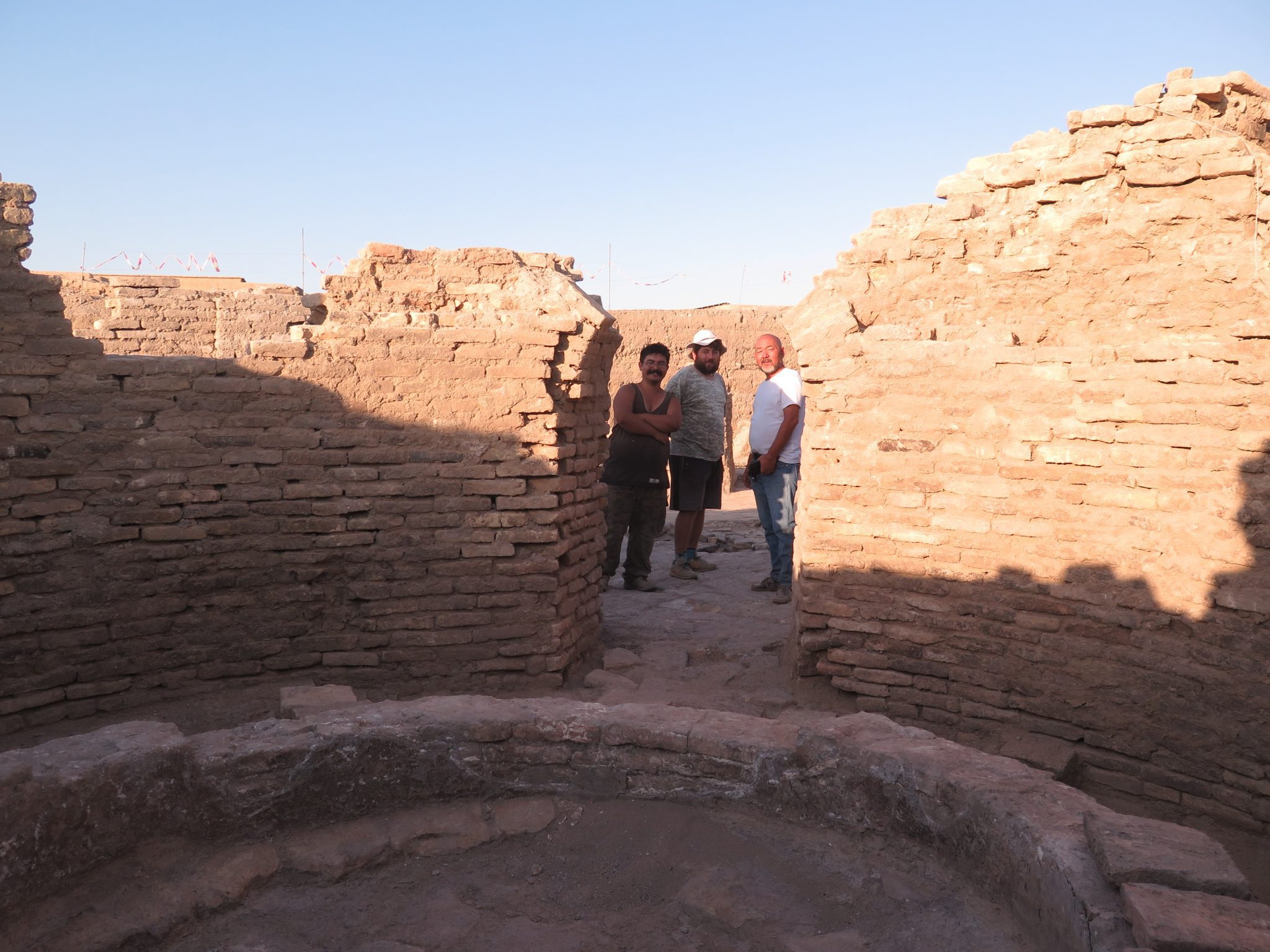
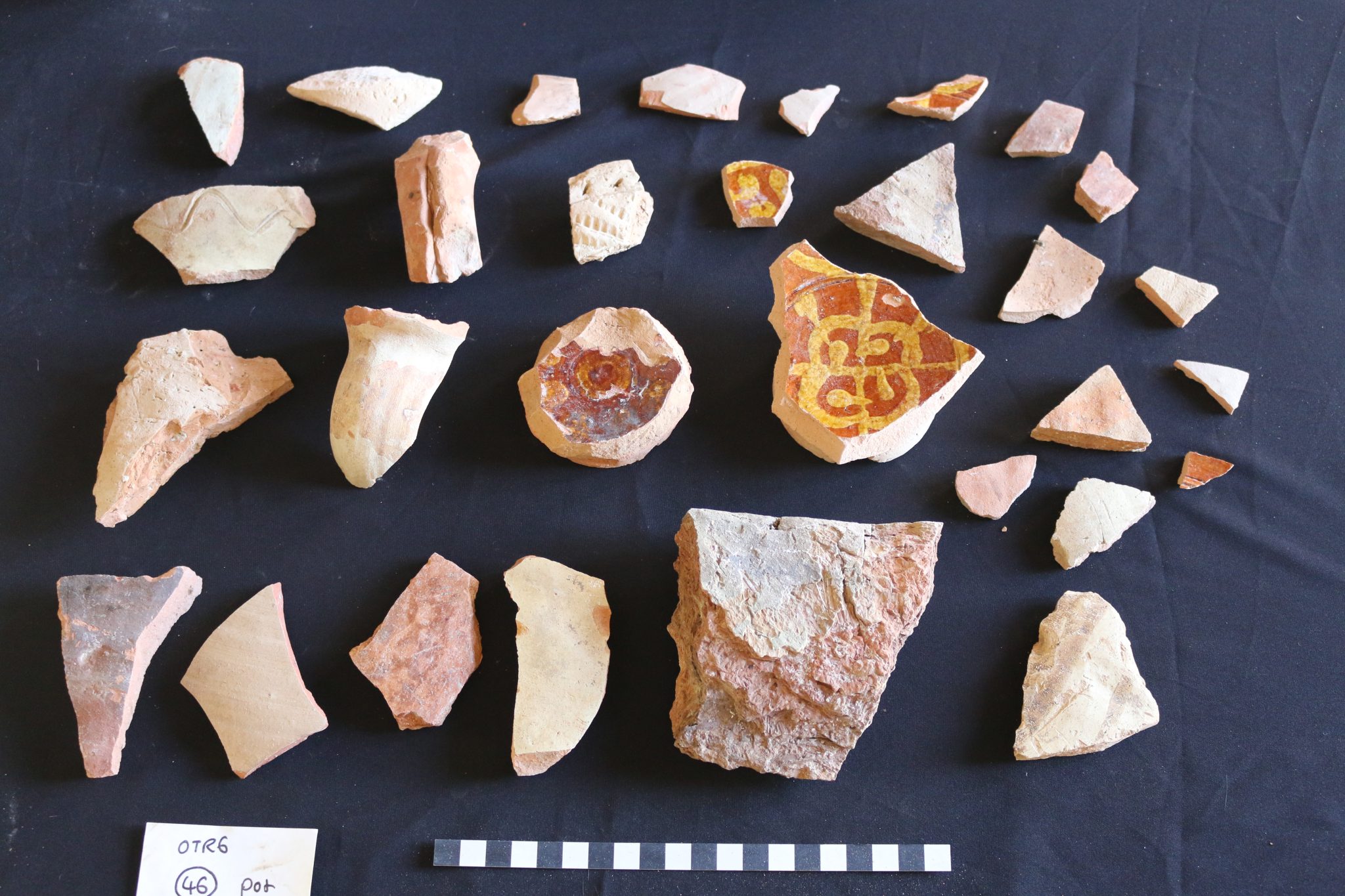
Research Team
Dr Katie Campbell
Project principal investigator.
Katie Campbell is a research fellow on the King’s Silk Roads Programme, King’s College, University of Cambridge and a fellow of the McDonald Institute for Archaeological Research. From 2022-24 she is also working with he Leverhulme- funded ‘Rivers of the Silk Roads’ project based at the University of Lincoln. Her research has focussed on the archaeological remains of large urban sites across Central Asia and the Caucasus, especially using them to understand periods of crisis such as the Mongol conquests of the early 13th century.
Serik Akylbek
Project co-investigator.
Serik Akylbek is the head of archaeology at archeoservice and the Otrar State Archaeological Museum, and a specialist in the archaeology of the Otrar Oasis.
Ali Seraliyev
Project co-investigator.
Ali Seraliyev is a PhD researcher at L.N. Gumilyov Eurasian National University in Astana, specialising on medieval settlement in the Otrar Oasis.
Year 1
In the first year of the project, we completed a five-week long excavation and survey season in September and October 2023. The team consisted of Dr Katie Campbell (King’s College, University of Cambridge), Serik Akylbek (Archeoservice, Otrar State Archaeological Museum), Dr Davit Naskidashvili (Tbilisi State University), Dr Karl Smith (University of Oxford), Ali Seraliyev (L.N. Gumilyov, Eurasian National University, Astana), Shinaz Almazuly (Archaeoservice, Otrar State Archaeological Museum) and students Vova Kenkadze, Vazha Chitaia (TSU) and Dinara Akylbek (Shymkent University). We were joined by James Thomas (University of Lincoln) who came to do soil salinity sampling at the site of Otrar and across the oasis.
The focus of the work was Otrartobe, the main urban site in the oasis, and its extensive suburbs. Karl Smith undertook geophysical survey using a gradiometer so that we could understand some of the material remains beneath the ground and target excavations appropriately at the large site. For this we focussed on various archaeological mounds within the suburbs, all of which proved to contain structures. We opened trenches on some of the most promising of these sites to target anomalies in the geophysics.
The main areas excavated included a substantial kiln which was found to be producing unglazed pottery in approximately the 14th century. Extensive samples were taken from the lining and fill of the kiln to understand more about its use and date. The dumps around the kiln contained an enormous amount of pottery, which we had to collect in large sandbags rather than the standard plastic finds bags. Washing and recording this pottery was a challenging job, but enthusiastically completed by Vova, Vazha and Dinara.
We also investigated sites in the northern and eastern part of the suburbs. In the north, we had an interesting anomaly on the geophysics, within an area where the city wall appeared to have been diverted to avoid. A small trench was excavated in this area, which contained occupation evidence dating from approximately the 10th-12th century, including a drainage pipe made from reused pots. These were sampled and palynological analysis is ongoing thanks to Dr Maia Chichinadze at the Georgian National Museum, Tbilisi. The trench in the eastern suburb contained buildings dating to a similar period, and we hope to excavate these further in 2024. In addition, we excavated a section through the city’s defensive wall to gain an idea of its construction and dating, and two canals providing water to the city and its suburbs. Analysis of material from all of the trenches is ongoing and alongside ongoing collaborative work with the Leverhulme-funded ‘Rivers of the Silk Roads’ project, these results will provide an important insight into the changing agricultural economy and the city of Otrar.
Year 2
2024-25 was the second year of a project to understand how the city of Otrar in southern Kazakhstan functioned agriculturally, the periods in which it thrived, and when and why it declined. A 5-week excavation season between 18th September and 24th October 2024, followed by analysis. Excavation focused on various trenches within the abandoned city to provide information about urban occupation and particularly the agricultural basis of the city’s economy and survival.
Two main trenches were excavated, with smaller investigations in 11 further trenches across the site. Trench OTR16 is a small mound of occupation located in the eastern suburb of the city. Initial excavations in 2023 indicated that it likely dates to the 12th century or earlier and so had potential to provide crucial pre-Mongol conquest (1220) data from the city. OTR23 is located on a mound next to the main canal which flows through the city’s western suburbs. Geophysical survey undertaken in 2023 indicated that there was likely dense occupation in this area, with inhabitants taking advantage of the fresh water flowing into this part of the city. The other trenches primarily targeted canals and fortification systems across the city’s suburb, and a small excavation was undertaken in OTR6, a deep trench on Otrar’s shahristan.
The excavations at OTR16 revealed a suburban settlement within the Otrar rabad which can be provisionally dated by pottery to the Qarakhanid period, likely the 10th-11th centuries. At least two phases of mudbrick buildings were discovered in the excavations. Within the buildings were an exceptional assemblage of Qarakhanid pottery as well as sophisticated waste and water management systems which were not fully excavated. In some sections, burnt deposits also provided the opportunity to collect charred seeds from floatation.
The other major trench, OTR23 also contained extensive occupation which from initial analysis appears to be from the Timurid period. It underlines the broad pattern of occupation we have observed at the site, with extensive activity in the northern and eastern suburbs up to around the 12th century, and later, Mongol and Timurid activity in the south and west of the city. Samples recovered from this trench will provide further information about changing subsistence patterns between the Qarakhanid and Timurid periods.
Additional trenches have enormously improved our understanding of Otrar’s defences and water management systems. Several trenches were excavated to investigate the city’s canals and reservoirs and initial palaynological analysis of soil samples revered from canals, toilets and agricultural soils indicate that there is a good survival of pollen at the site and a wide range of both wild and domestic taxa present. The study was carried out by Maia Chichinadze at the Georgian National Museum, and we hope to build on these initial findings to get a sense of the vegetation in and around the city from approximately the Arab conquests to the Timurid period.
Analysis of the samples and archaeological records is also continuing, with two MPhil students from Cambridge helping to sort and identify archaeobotanical samples from Otrar. I also received the results of the initial round of C14 dating which indicate a range of archaeobotanical material from the 7th-16th centuries has so far been excavated during this phase of excavation at Otrar.
References
Akylbek, S. Sh. 2013. “Otyrar Qamaldary [Otrar Defenses].” Otyrar Mūralary/ Tarikhi-Mădeni, Ghylymi-Tanymdyk Zhyrnal [Otrar Heritage: Culture-Historical and Culture Journal] 2 (3): 13–30.
Campbell, Katie. 2020. “The City of Otrar, Kazakhstan: Using Archaeology to Better Understand the Impact of the Mongol Conquest of Central Asia.” Pp. 597–606 in Proceedings of the 11th International Congress on the Archaeology of the Ancient Near East, edited by L. K. and A. H. Adelheid Otto, Michael Herles, Kai Kaniuth. Wiesbaden: Harrassowitz Verlag.
Campbell, Katie. 2021. “Cities and the Mongol Conquest: Urban Change in Central Asia 1200-1400.” PhD Thesis: University of Oxford.
Campbell, Katie, Ali Seraliyev, Davit Naskidashvili, and Serik Akylbek. 2022. “Urbanism Under Turco-Mongol Rule: Excavations in Otrar, Kazakhstan.” TSU-TI: The International Scientific Jounral of Humanities 1: 9–23.
Clarke, D., R. Sala, and E. Meseth. 2005. “Reconstructing Irrigation at Otrar Oasis, Kazakhstan, AD 800-1700.” Irrigation and Drainage 54 (May): 375–88.
Groshev, V. A. 1985. Irrigatsiia Iuzhnogo Kazakhstana v Srednie Veka [Irrigation in Kazakhstan in the Medieval Period]. Alma-Ata: Nauka Kazakhskoĭ SSR.
Toonen, Willem H. J., Mark G. Macklin, Giles Dawkes, Julie A. Durcan, Max Leman, Yevgeniy Nikolayev, and Alexandr Yegorov. 2020. “A Hydromorphic Reevaluation of the Forgotten River Civilizations of Central Asia.” Proceedings of the National Academy of Sciences of the United States of America. doi: 10.1073/pnas.2009553117.
